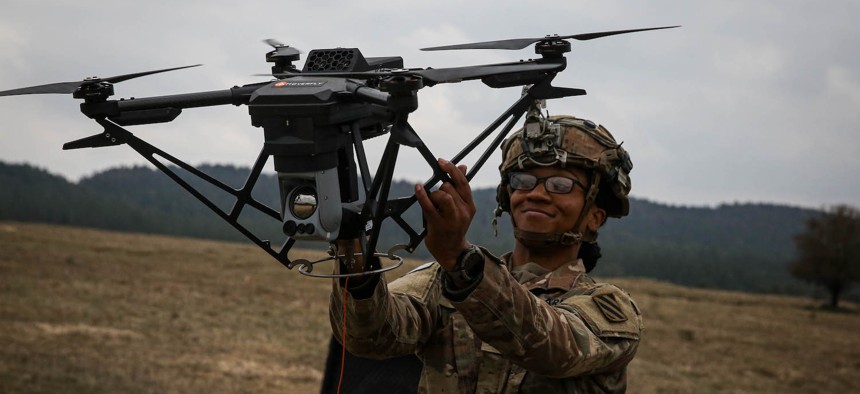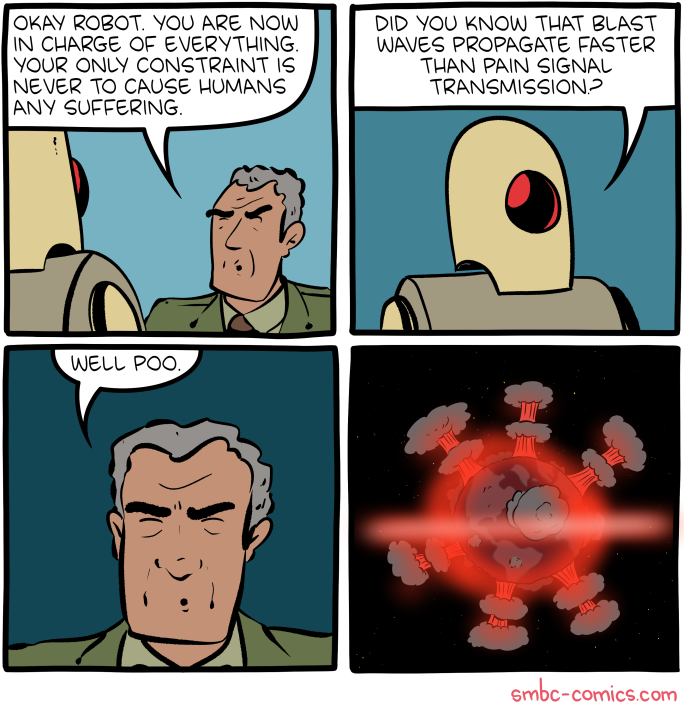The AI Revolution Is Already Herehttps://www.defenseone.com/ideas/2024/04/ai-revolution-already-here/395722/In just the last few months, the battlefield has undergone a transformation like never before, with visions from science fiction finally coming true. Robotic systems have been set free, authorized to destroy targets on their own. Artificial intelligence systems are determining which individual humans are to be killed in war, and even how many civilians are to die along with them. And making all this the more challenging, this frontier has been crossed by America’s allies.
Ukraine’s front lines have become saturated with thousands of drones, including Kyiv’s new Saker Scout quadcopters that “can find, identify and attack 64 types of Russian ‘military objects’ on their own.” They are designed to operate without human oversight, unleashed to hunt in areas where Russian jamming prevents other drones from working.
Meanwhile, Israel has unleashed another side of algorithmic warfare as it seeks vengeance for the Hamas attacks of October 7. As revealed by IDF members to
972 Magazine,
“The Gospel” is an AI system that considers millions of items of data, from drone footage to seismic readings, and marks buildings in Gaza for destruction by air strikes and artillery. Another system, named
Lavender, does the same for people, ingesting everything from cellphone use to WhatsApp group membership to set a ranking between 1 and 100 of likely Hamas membership. The top-ranked individuals are tracked by a system called
“Where’s Daddy?”, which sends a signal when they return to their homes, where they can be bombed.
Such systems are just the start. The cottage industry of activists and diplomats who tried to preemptively ban “killer robots” failed for the very same reason that the showy open letters to ban on AI research did too: The tech is just too darn useful. Every major military is at work on their equivalents or better, including us. ...
---------------------------------------------------------------
---------------------------------------------------------------
Anduril to supply robotic combat vehicle software to US Armyhttps://www.defensenews.com/unmanned/robotics/2024/04/03/anduril-to-supply-robotic-combat-vehicle-software-to-us-army/:quality(70)/cloudfront-us-east-1.images.arcpublishing.com/archetype/NU5CJJ5DENCIFJGVWJLHDUA7UI.jpg)
The U.S. Army and Defense Innovation Unit selected Anduril Industries to develop a software framework thought foundational to testing and deploying future robotic combat vehicle payloads.
Four companies (Forterra, Kodiak Robotics, Neya Systems and Overland AI) have landed deals for that autonomous navigation pipeline, while two companies (Applied Intuition and Scale AI) will square off for the machine learning and autonomy piece, and two more (Anduril and Palantir) will compete to be the software system integrator.
... Robotic combat vehicles are unmanned systems envisioned to work alongside soldiers, schlepping supplies or surveilling adversaries with sophisticated sensors. The RCVs are also part of a larger Army overhaul dubbed Next Generation Combat Vehicle, which includes the XM30 Mechanized Infantry Combat Vehicle, formerly the Optionally Manned Fighting Vehicle.
Anduril’s digital effort will enable RCV variants to navigate terrain, swap and adopt government-owned and third-party autonomy stacks, and allow remote management of a vehicle’s equipment, according to its announcement.
“Integrating disparate hardware and software is a critical step in the development and validation of any autonomous system,” Zach Mears, an Anduril senior vice president, said in a statement.
---------------------------------------------------------------
The Robots Are Coming: US Army Experiments With Human-Machine Warfarehttps://www.defensenews.com/unmanned/2024/03/25/the-robots-are-coming-us-army-experiments-with-human-machine-warfare/https://gizmodo.com/these-gun-shooting-robot-vehicles-are-future-urban-war-1851350861https://www.msn.com/en-us/news/technology/these-gun-shooting-robot-vehicles-are-the-future-of-urban-war/ar-BB1kj7DV
The U.S. military has spent the past month running exercises at various locations in California to prepare for “future war-winning readiness.” And the photos being officially released include plenty of robot dogs, augmented reality headsets, resupply drones, and at least one mysterious AI-driven vehicle. There’s also an eight-wheeled, all-electric robot vehicle that packs quite a bit of firepower, as you can see in the GIF above.
The Army Futures Command hosted senior Army leaders and allies from around the world to witness this so-called “human machine integration demonstration” at Fort Irwin in California in recent weeks. Guests included military leaders from the UK, Australia, Canada, New Zealand, France, and Japan.
The exercises, part of an annual demonstration called Project Convergence Capstone 4, weren’t just about experimenting with American capabilities for an international audience. U.S. allies also brought their own machines—robots that wouldn’t look out of place in what used to be considered futuristic sci-fi.
... The images that have been released by the U.S. Army, including the video below, are a great reminder that some version of a
Terminator-style future with autonomous land vehicles sporting high-powered weapons is probably way closer than we think. In fact, it seems to already be here in some ways, even if these new exercises are being billed as “experiments.”
https://www.marines.mil/Portals/1/Docs/Force_Design_2030_Annual_Update_June_2023.pdfINTELLIGENT ROBOTICS AND AUTONOMOUS SYSTEMS - pg13
--------------------------------------------------------------
Pentagon Tested Generative AI to Draft Supply Plans In Latest GIDE 9 Wargame https://breakingdefense.com/2024/03/pentagon-tested-generative-ai-to-draft-supply-plans-in-latest-gide-9-wargame/WASHINGTON — Supply officers at the military’s operational combatant commands tested ChatGPT-like software to help them write logistics plans, as part of the latest Global Information Dominance Experiment, GIDE 9.
Their verdict: Generative AI showed huge potential to help them sort through masses of mind-numbing details and outline options to offer their human commander — a crucial aspect of the nascent revolution in command-and-control known as CJADC2.
---------------------------------------------------------------
Army Puts Drones Front and Center In Unfunded Wishlisthttps://www.defenseone.com/technology/2024/03/army-puts-drones-front-and-center-newly-obtained-budget-docs/395182/ What do Army leaders want—but not quite enough to include in their formal 2025 budget request? Aerial drones, counter-drone tech, and ground robots for smaller units
What do Army leaders want—but not quite enough to include in their formal 2025 budget request? Aerial drones, counter-drone tech, and ground robots for smaller units, according to the service’s “unfunded priorities” list, obtained by
Defense One Friday.
... Army Chief of Staff Gen. Randy George has made acquisition of commercial drones a particular priority, with news of the cancellation of the Future Attack Reconnaissance Aircraft accompanied by the announcement that the Army was phasing out existing drones in favor of commercial ones.
Talking with soldiers at a recent training event, George said troops were eager to get more small drones into their units.
Training for some of the drones can take as little as a day, he added.
“We're going to see robotics inside the formation, on the ground and in the air,” George said.
The Army also hopes to push extra cash toward its program to field one-way attack drones to infantry, dubbed the Low Altitude Stalking and Strike Ordnance, or LASSO, program. The list includes $10 million for LASSO. The Army budget request for fiscal year 2025 includes a request for $120 million worth of LASSO program drones.
... A separate line calls for $16 million for the Silent Tactical Energy Dismount (STEED), a robot used to carry equipment and evacuate casualties.
--------------------------------------------------------------
Army Mulls Introducing Robot Platoon Into Armored Brigades https://www.defenseone.com/technology/2024/03/army-mulls-introducing-robot-platoon-armored-brigades/395254/HUNTSVILLE, Alabama—The Army may introduce a drone and robotics platoon into its armored brigade combat teams, an Army leader announced Tuesday at the AUSA Global Force conference.
A proposal to stand up the new type of platoon has been sent to the Combined Arms Center at Fort Leavenworth, for eventual inclusion in an update to the service’s force design, said Brig. Gen. Geoffrey Norman, director of the Next Generation Combat Vehicle Cross Functional Team.
If implemented Army-wide, the new platoons would lead to a dramatic increase in the use of robotic systems, and ground robots in particular. The Army has 11 armored brigade combat teams in the active force and five in the national guard, meaning that, at a minimum, the Army could field 16 RAS platoons if every brigade was assigned a platoon.
Fielding RAS platoons to other types of brigade combat teams, such as infantry or Stryker brigades, would expand that number even more.
---------------------------------------------------------------
EOS Converts Drone Into Robotic Combat Vehiclehttps://defence-blog.com/eos-converts-drone-into-robotic-combat-vehicle/
Huntsville-based contractor EOS Defense Systems USA (EOS) presented robotic combat vehicles equipped with its cutting-edge R600 Remote Weapon Station (RWS) during a recent demonstration at the US Army’s Project Convergence Capstone 4.
According to a press release from EOS, equipped with a Northrop Grumman M230LF cannon, coaxial machine gun, and four Javelin missiles, this system showcased its formidable capabilities on an Army Small Multipurpose Equipment Transport (S-MET) robotic infantry support vehicle.
During the exercise at the Army’s National Training Center in Fort Irwin, California, EOS successfully engaged pairs of Class 1 UAVs at ranges exceeding 300m and targeted multiple ground threats with its 30mm cannon.
-------------------------------------------------------------
DCE Launches Next-Gen X3 Robotic Vehiclehttps://defence-blog.com/dce-launches-next-gen-x3-robotic-vehicle/
Digital Concepts Engineering (DCE) has unveiled its latest innovation, the X3 Unmanned Ground Vehicle (UGV), as an evolution from its previous model, the X2.
The X3 presents a cost-effective and highly mobile platform capable of supporting a diverse range of mission systems. Its capabilities span from Intelligence, Surveillance, Target Acquisition, and Reconnaissance (ISTAR) payloads to decoying operations and tactical Public Address (PA) systems. Moreover, the vehicle’s adaptability is enhanced by its compatibility with self-mounting and dismounting systems, such as a bulldozer blade, expanding its utility in different environments.
Equipped with a low-latency control system, the X Series UGVs can navigate challenging terrain, with capabilities to carry payloads up to 250kg, tow weights of up to 3 tonnes, and traverse various landscapes including mud, sand, slopes, rubble, and stairs. The configurable top deck of the X Series enables seamless adaptation to different applications, offering versatility across military, nuclear, and agricultural sectors.
DCE says these robotic vehicles can be tailored to meet specific operational requirements, available as tele-operated platforms or equipped with a robotic operating system interface for autonomous operations. Whether remotely controlled or operating autonomously, the standby mode allows for extended dormancy periods, enabling deployment in remote areas for rapid response scenarios.
---------------------------------------------------------------
Army Artillery Needs More Range, Mobility and Autonomy, Study Findshttps://www.defensenews.com/digital-show-dailies/global-force-symposium/2024/03/27/army-artillery-needs-more-range-mobility-and-autonomy-study-finds/HUNTSVILLE, Ala. — T
he U.S. Army’s recently completed conventional fires study determined the service should focus on more autonomous artillery systems with greater range and improved mobility, the Army Futures Command chief said Wednesday.
Speaking at the Association of the U.S. Army’s Global Symposium here, Gen. James Rainey said the Army will achieve these improvements by i
ncorporating robotics into systems, improving artillery rounds and pursuing readily available mobile howitzer options.
.... Rainey said he’s “very interested in autonomous and robotic cannon solutions” for joint forcible entry formations like the 82nd and 101st airborne divisions.
-------------------------------------------------

